Zdeněk Dvořák, Special education needs teacher, Czech Republic
 When water freezes outside and the land is coated with snow, it is the right time for the annual hog killing. This dated Czech tradition is usually organized between November and March and it is such an event that many families rank its importance along Birthdays or Christmas Holidays. One of the families to hold such a tradition is the Prčík family, well known from the weeks of Zdeněk Dvořák. And due to the decline of this tradition, mainly because of financial reasons and lack of time, we now have a single opportunity to experience what goes on in the backyard of the Prčík family and enjoy the atmosphere of everything that is involved with this event. Before continuing further however, we would like to warn you that the content of the photographs is not for individuals with a weak stomach. Additionally, we’d like to emphasize the fact that the time and care devoted to the animal as well as the process of killing the pig, which is by the way fast and almost painless, in this case favors the Czech local hog killings as opposed to the wholesale slaughter houses. Still, today, local hog killing is considered as animal torture and condemned by a wide spectrum of people around the world. (WoL)
When water freezes outside and the land is coated with snow, it is the right time for the annual hog killing. This dated Czech tradition is usually organized between November and March and it is such an event that many families rank its importance along Birthdays or Christmas Holidays. One of the families to hold such a tradition is the Prčík family, well known from the weeks of Zdeněk Dvořák. And due to the decline of this tradition, mainly because of financial reasons and lack of time, we now have a single opportunity to experience what goes on in the backyard of the Prčík family and enjoy the atmosphere of everything that is involved with this event. Before continuing further however, we would like to warn you that the content of the photographs is not for individuals with a weak stomach. Additionally, we’d like to emphasize the fact that the time and care devoted to the animal as well as the process of killing the pig, which is by the way fast and almost painless, in this case favors the Czech local hog killings as opposed to the wholesale slaughter houses. Still, today, local hog killing is considered as animal torture and condemned by a wide spectrum of people around the world. (WoL)
 Year by year, every summer, farmers venture out to buy a grown piglet. For several months, they cater for it day by day. They feed it leftovers from the kitchen, potatoes, turnip, moist bread, grouts and even goat milk. The piglet keeps growing and growing, gains an appetite for almost anything and its weight starts closing in on the 200 kg benchmark. As the weight grows, the winter season slowly approaches and with it the season of traditional hog killing. It is a village tradition, which is slowly fading away from most farms and estates. The main reason for it is the fact that it’s not worth it to take care of a single pig for almost half a year. People tend to buy their meet in shops these days. It’s a shame however, since annual hog killing belongs among the largest traditions of the countryside, where the whole family gets together and it is often considered as important as the Christmas holidays. This is the case of the Prčík family in the village of Slup located in the Znojmo region, where hog killing still prevails as an annual tradition.
Year by year, every summer, farmers venture out to buy a grown piglet. For several months, they cater for it day by day. They feed it leftovers from the kitchen, potatoes, turnip, moist bread, grouts and even goat milk. The piglet keeps growing and growing, gains an appetite for almost anything and its weight starts closing in on the 200 kg benchmark. As the weight grows, the winter season slowly approaches and with it the season of traditional hog killing. It is a village tradition, which is slowly fading away from most farms and estates. The main reason for it is the fact that it’s not worth it to take care of a single pig for almost half a year. People tend to buy their meet in shops these days. It’s a shame however, since annual hog killing belongs among the largest traditions of the countryside, where the whole family gets together and it is often considered as important as the Christmas holidays. This is the case of the Prčík family in the village of Slup located in the Znojmo region, where hog killing still prevails as an annual tradition.
The date of the event is planned several weeks ahead by the family who organizes it. Every year it is held on a Saturday at the end of November or beginning of December. It all depends on the family’s butcher, who above all is the reason for success. You can’t just kill and portion the pig; the butcher needs to prepare all the goodies such as blood sausages or collared pork.
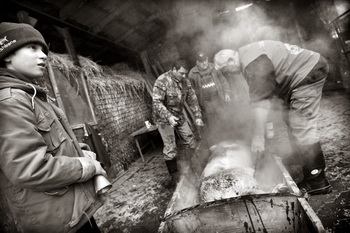 |
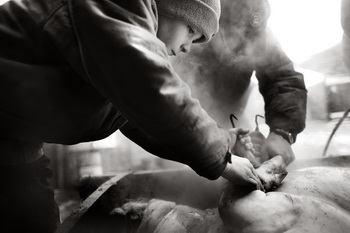 |
The day before the hog killing, water needs to start boiling in a large caldron. The place where the hog killing happens, usually a yard of the estate, is thoroughly cleaned by then and all the necessities such as a hand barrow for the pig are prepared. Tables are cleaned, wood for heating the fire under the caldron is prepared in a sufficient amount and the pig is no longer fed anything else than water.
It’s Saturday morning, still dark outside and Mr. Prčík wakes up to heat up the kitchen and keep the fire going under the caldron outside. Someone has to go for several loaves of bread and some rolls that are later used in making the sausages. The dawn approaches and the family members are starting to get together. Cars are lining up and among them, the car of the butcher. The yard is filled with around 15 people from the ages of 3 to 85. It’s 8 o’clock and the butcher is ready. The last necessity before it all happens is a shot of plum brandy to keep the people warm. The moment is here, disliked by many from the village still after the years. It is time to get the pig from the barn.
It is calmly taken outside, where the last thing that awaits him is the fatal knock on the head. Pain and stress is minimal and it only lasts a few seconds, unlike the process in a slaughter house. Hence, the hard, dirty and demanding work begins. A fair amount of weight needs to be put on the pig, so it usually takes several men to smother the pig and it can often be dangerous. At that moment, the pig’s throat is cut and the blood is immediately being used for the blood soup and mixed with pre-prepared groats for blood sausages. Next, the pig is put onto the hand barrow, covered with rosin and scalded, in order to be able to rub off the pig’s bristles.
 It’s a messy job, usually handled by several men, who are deep in the reeking smell of the rosin and the pig’s rubbed down skin. Then, the pig is hung and it’s time for the butcher to do what he knows best; he disembowels and portions the pig. While the butcher continues his work, it is time for another shot of plum brandy, mulled wine, a piece of cake or a bottle of Pilsner. The Pilsner Urquell beer is somewhat of an indication that it is a special day in the Prčík family. Mr. Prčík is not a frequent visitor of pubs and only on occasion buys beer from Pilsen, which really has become an important part of every significant day in the life of the Prčík family. From here on, work for the female part of the family begins in the kitchen. First, pork brain is fried and mixed with eggs and the first food of the hog killing can be served.
It’s a messy job, usually handled by several men, who are deep in the reeking smell of the rosin and the pig’s rubbed down skin. Then, the pig is hung and it’s time for the butcher to do what he knows best; he disembowels and portions the pig. While the butcher continues his work, it is time for another shot of plum brandy, mulled wine, a piece of cake or a bottle of Pilsner. The Pilsner Urquell beer is somewhat of an indication that it is a special day in the Prčík family. Mr. Prčík is not a frequent visitor of pubs and only on occasion buys beer from Pilsen, which really has become an important part of every significant day in the life of the Prčík family. From here on, work for the female part of the family begins in the kitchen. First, pork brain is fried and mixed with eggs and the first food of the hog killing can be served.
“…annual hog killing belongs among the largest traditions of the countryside, where the whole family gets together and it is often considered as important as the Christmas holidays.”
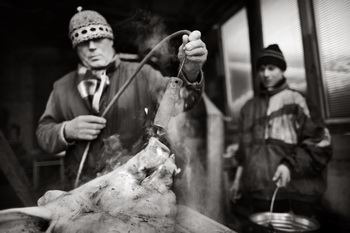 |
 |
First small parts of roast meat are being prepared and the caldron, covered with clouds of steam, is full of boiled pork. The yard is finally filled with a tasty smell. At this moment, the hog killing becomes more of a form of entertainment for most, since most of the hard work is done. However, it is necessary to keep watching the boiled pork or start preparing skin fat for frying. So, even though it’s time to have fun, there is still work to be done. Once the butcher portions the meat, intestines are immediately cleaned and used to make various sausages. The more experienced start to prepare skewers. The yard is slowly emptied and everyone moves to the adjacent porch where the preparations of the food are finished.
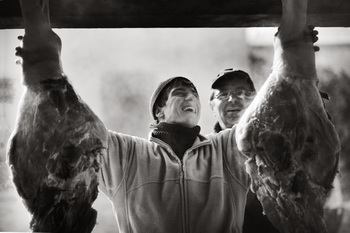 |
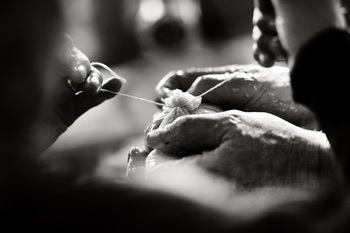 |
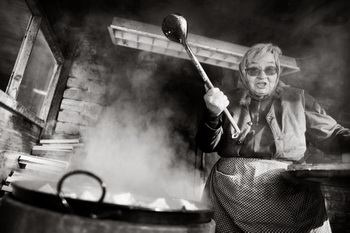 |
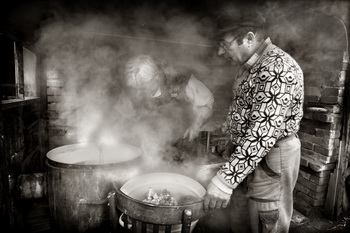 |
“You suddenly feel the urge to take a slice of bread, some pickles, put salt on the fried skin fat and enjoy the taste.”
The work is distributed by the butcher and so the stirring, seasoning and the rest of the hog killing alchemy is in motion, resulting in the best collared pork, sausages, blood sausages and so on. The time passes by and it’s almost time for a second bottle of the plum brandy. Everyone’s hands are greasy and the only thing you can smell in the air is meat. People are having fun and feel at ease. One of the last things to do is to finish up with the sausages and leave them to cool off. You need to be extra careful though and keep out cats and other animals that could spoil the day. If it’s not too late in the day, it is the right time to fry the skin fat. A smaller caldron is filled with the fat and left to fry in its own grease. It soon reaches the correct golden color and rest of the sizzling fat is taken out. You suddenly feel the urge to take a slice of bread, some pickles, put salt on the fried skin fat and enjoy the taste. Even though your intake of fats is long over the daily limit, you just simply cannot resist.
 |
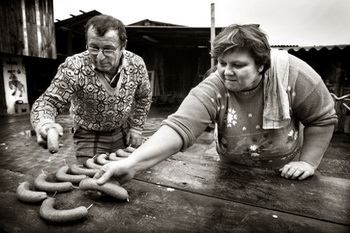 |
Darkness covers the event and work is done for the day. Much work is left for the next day. The meat needs to be smoked, portioned for other forms of cooking and the rest has to deepfreeze; and of course, we cannot forget about cleaning the yard and all the other necessities. And yes, it all needs to be done on a Sunday. At dusk, everyone who contributed in one way or the other gets a small taste of what was made to take with them and slowly departs for their home. And that is how it goes at the Prčík’s each year! A pig named Vašek recently reached nearly 200kg of weight and so the day when the whole family gets together once again happened.
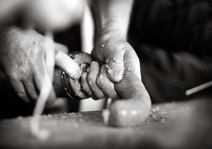 |
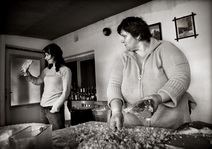 |
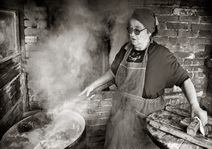 |
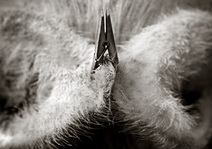 |
 |
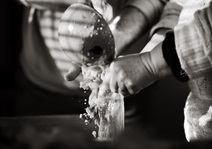 |
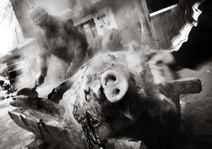 |
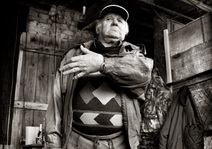 |
 |
